What can a 6-month-old baby do? Milestones guide

The child is now six months old! This is a date that parents approach in a special way. The baby does not grow as rapidly as in the previous months of life. Nevertheless, the development of a child at 6 months shows the large difference between a six-month-old baby and a completely helpless newborn. Children at this age begin to demonstrate new skills that were not even hinted at a few months ago.
Young mothers and fathers compare their son or daughter with other children and naturally ask themselves: what a child should be able to do in the sixth month of their life, and whether their baby meets the standards of development. Although each baby is different, you can compare the development of your child with the average standards that pediatricians are guided by.
Contents:
- Physical development
- What should a child do at the age of 6 months?
- Sleep, feeding, and daily routine
- 6-month-old baby games and toys
- Taking care of a 6-month-old child
- The doctor’s opinion
- Frequent issues and solutions
- How to help the child to develop?
Physical development

Prostock-studio/Shutterstock.com
According to the average indicators, the 6-month-old child can do the following:
- knows how to roll over from one side to another easily, as well as roll from back to stomach and vice versa;
- leans on their hands for a long time when lying in a prone position;
- begins to make their first movements that resemble crawling.
These skills, such as rolling over, resting on hands, and attempting to crawl indicate the norm of development in a 6-months-old baby.
If it seems to you that your child has poor body control — for example, they cannot roll over or are unable to support their body weight with their hands when they lie on their stomach, film the child’s behavior that makes you worried and show the recording to the doctor.
Other indicators, for example, height, weight, and sitting ability will depend on the characteristics of every child.

Prostock-studio/Shutterstock.com
The table below shows the average values for height, weight, head circumference in babies of this age:
| Boys, height and weight | Girls, height and weight | Boys, head circumference | Girls, head circumference | Boys, chest circumference | Girls, head circumference |
| 63,5-72 cm; 6,7-8,5 kg | 62-70 cm; 6,5-8,5 kg | 41-44 | 40-44 | 41-48 | 41-46 |
⠀
The parameters mentioned above are approximate, and if your baby was already noticeably more or less than other newborns at birth, you can calculate their weight norm by using the following formula: weight at discharge from the hospital + 800 and multiplied by 6. The result obtained corresponds to the approximate weight that the child should have by the age of six months.
The calendar of the development of physical indicators in the first year is uneven, as the most active growth and weight gain occurs in the first four months of a child’s life. By the sixth month of life, the baby gains around 600-700 grams of weight, grows by two to three centimeters, and their head and chest circumferences become larger by 1 and 1-2 centimeters, respectively.
Many babies have their first tooth by six months. Although it is not uncommon for the first tooth to appear earlier, at 3-4 months, or later, at 8-10 months. Pediatricians consider the eruption of the first tooth to be the norm up until the first year of life.
The difference between boys and girls

Prostock-studio/Shutterstock.com
Children of different genders that have crossed the 6-month-old milestone are not very different from each other: boys and girls have approximately the same height and weight, they also possess similar skills. Doctors note that girls usually begin to sit steadily and try to get up earlier than boys. The remaining parameters of the development of children at six months are on average the same, regardless of gender.
Pediatricians advise against speeding up the learning process for independent sitting when it comes to girls. If a girl does not want to sit down on her own or sit for a long time, do not sit her down. This way, you will avoid the traumatic stress on the spine and reproductive system of your daughter.
Physical particularities
What does a child know how to do at the age of 6 months:
- turning over easily and leaning on their hands while lying on their stomach;
- muscle hypertonicity disappears fully or almost fully, the baby starts controlling their limbs well;
- the child is now lying on the stomach for a long time and with pleasure;
- the sucking reflex decreases — the child can learn to eat from a spoon;
- the baby kicks off with their legs sharply from any surface when an adult holds them by their armpits.
What should a child do at the age of 6 months?

Prostock-studio/Shutterstock.com
At the age of six months, the child develops new skills and improves their existing ones. Their daily schedule changes as 6-month-old babies are introduced to complementary foods. The child starts perceiving games and toys in a new way, and even the daily caring routine for the baby becomes different.
The main skills
Skills that a six-month-old baby is proficient in:
- displaying interest in all objects that come into their sight, trying to grab and study them;
- trying to sit on their own and sitting steadily if an adult has helped them to adopt a sitting position;
- trying to stand with the support, and raising one hand from this position, whilst maintaining balance;
- making the first attempts to crawl with characteristic movements, from a prone position. Some children can even get up on all fours;
- expressing affection not only for the mother but also for other close people.
Movement activity, fine motor skills, and reflexes

Prostock-studio/Shutterstock.com
Physical activity and motor skills of a six-month-old child, which are used to assess whether the development of the baby, meet the following norms:
- the baby has got a good grip with the palm of their hand: they take an object on their own, hold it firmly in one or both hands and move it from hand to hand;
- they consciously use their hands. For example, they understand that a fallen toy needs to be picked up;
- children do not get tired when lying on their stomach and sitting down for a short period of time, coupled with the willingness to change poses, thanks to the strengthened muscles of the back.
At the age of six months old, the baby retains the reflex of automatic walking and support, which is inherent in children from birth to the age of 8 months: the child straightens their legs if an adult helps them to adopt a standing position, and steps over their legs, as if imitating walking.
A new more complex reflex emerges, which is the straightening reflex of the body. When the baby’s head is turned to the side, they turn their body and pelvis in the same direction.
Intellectual development

Prostock-studio/Shutterstock.com
A six-month-old child displays a noticeable leap in intellectual development relative to their previous stage of life. A healthy baby is doing the following:
- displays interest in surrounding objects up to the point of examining and playing with a toy for 10-20 minutes with enthusiasm and without attracting the attention of parents;
- distinguishes between familiar and unfamiliar people efficiently and expresses alertness and fear with strangers;
- understands that their purposeful actions cause certain consequences: for example, when they would press on a sound toy, it will start playing music;
- knows their name, reacts to their name being called;
- distinguishes between the mood of people around through the intonation of their speech and reacts with a smile or with tears, depending on the circumstances;
- the “testing” method becomes one of the most important methods of exploring the world and the objects of interest.
Psychological development: mood and emotions
Here are the most common manifestations of the emotional state of a six-month-old boy or girl:
- staying in a good mood for a long time when their attention is caught by toys;
- stopping to use crying as a means of attracting attention and crying only if hungry or uncomfortable;
- expressing various emotions, such as surprise, joy, fright, and grief with the help of facial expressions and voice;
- associating their mood with the mood of loved ones, especially the mother: if the mother is in a good mood, the baby is also in a good mood, if the mother is upset, the baby will start throwing tantrums.
Sensory organs: the perception of the child’s surrounding world
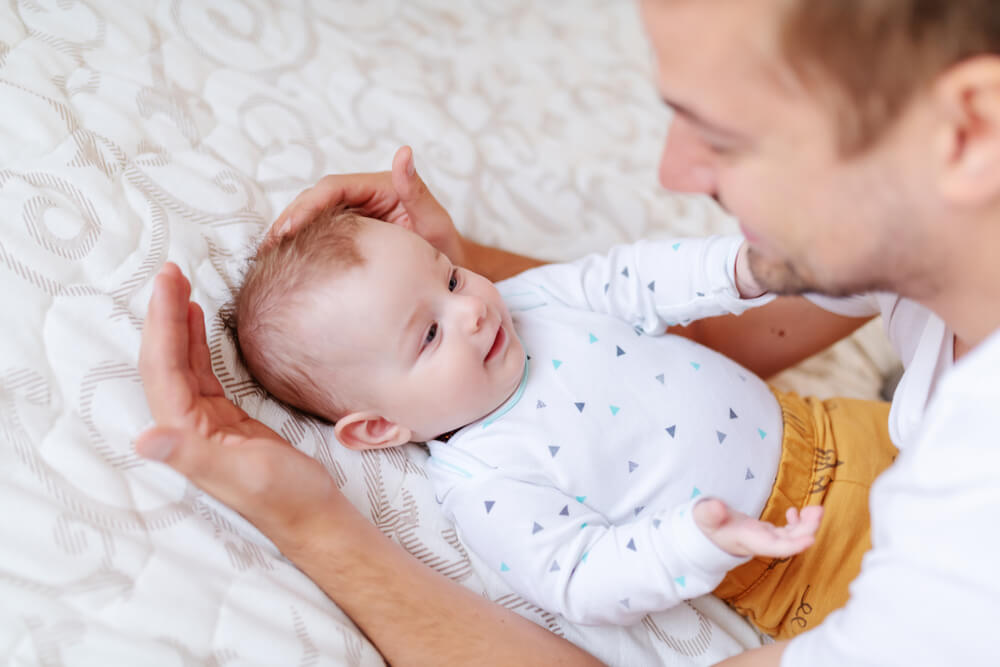
Prostock-studio/Shutterstock.com
At six months, the child’s sense organs are not as well developed as in adults and older children, however, they already function much better than in newborns. A six-month-old baby already knows how to focus their gaze on a certain object and they can distinguish bright colors efficiently.
The baby’s taste buds also develop: the child starts feeling a sweet, bitter, and salty taste. The ability to distinguish all faces of taste will develop later, approximately by the time that the child goes to school.
Pain sensitivity increases. The child feels pain more sharply compared to the period when they were just born.
Hearing, smell and touch are already well developed in newborns; they remain at the same level at the age of six months.
Speech
By the age of 6 months old the child surely does not produce meaningful speech yet. However, their sounds change: the child does not grumble anymore, they rather babble, trying to turn sounds into syllables. Gradually, the baby begins to pronounce separate, audible syllables, whilst trying to repeat the sounds after adults.
Sleep, feeding, and daily routine

Prostock-studio/Shutterstock.com
Growing up, children sleep less and less, however, to the relief of their parents, they sleep much more soundly than before. A six-month-old baby has got two to three naps a day and often sleeps through the night, especially if they are formula-fed. The duration of sleep varies depending on the particularities of the child and their daily routine. Daytime sleep can take anything between 30 minutes and 2-3 hours. At night, the child should sleep up to 9-10 hours without waking up.
Six months is the age at which it is imperative to introduce complementary foods if you have not done so yet. If you continue to feed your baby only with breast milk or formula, the risk of allergies to new foods will significantly increase in the future.
Food that is safe to be the child’s first meal:
- lactose and gluten-free porridges;
- single component fruit and vegetable purees;
- children yogurt or cottage cheese.
When the child gets used to the first complementary foods and you make sure that the foods do not cause allergies, you can gradually add the following new foods to the menu:
- milk-based porridges;
- fruit and vegetable multi-component purees;
- meat puree.
The 6-month-old baby continues to be fed on breast milk or formula on demand. If the child is bottle-fed, give them the bottle only after they have eaten a small number of other foods, such as porridge, puree, or cottage cheese.
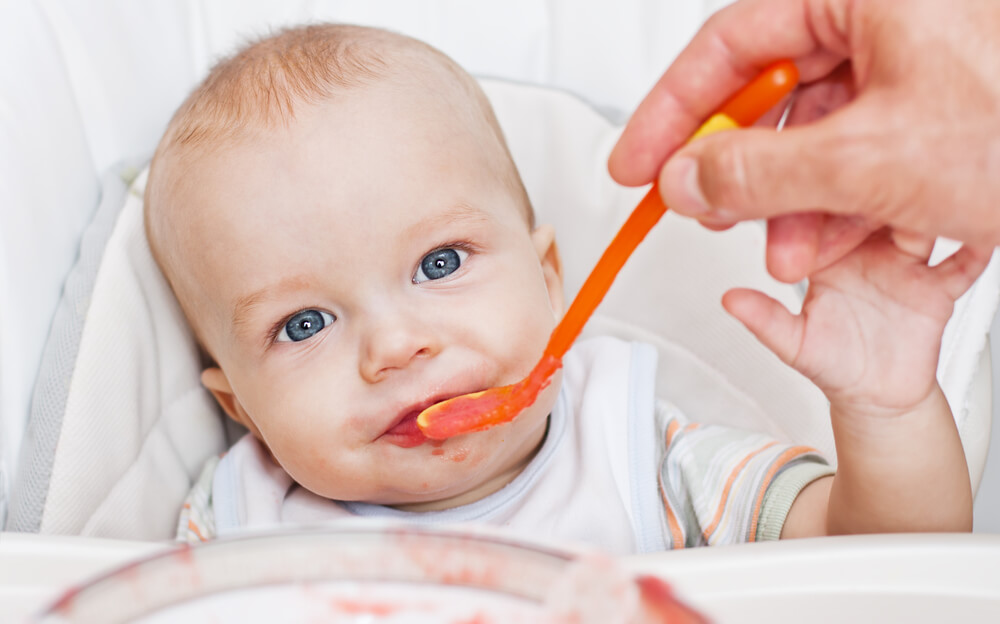
Prostock-studio/Shutterstock.com
Food that is not safe for 6-month-old children:
- whole milk;
- any foods that are not blended to a puree consistency;
- food not suitable for the child’s age, for example, juices with an indication that they are intended for children over the age of three years old.
A daily routine without major changes is useful for children: they sleep better and throw fewer tantrums. Try to stick to a roughly stable daily routine until your baby is 8-10 months old, the age when their time for sleep will decrease again.
Here is an example of a daily timetable:
- 7.00 — waking up, hygienic procedures, feeding;
- 8.30 — daytime nap;
- 10.30 — waking up, feeding and games;
- 12.00 — walk;
- 14.00 — feeding upon returning at home;
- 14.30 — games that foster the child’s development;
- 16.00 — walk, combined with daytime sleep;
- 17.30 — feeding at home;
- 18.00 — playing with toys and interacting with parents;
- 20.30 — hygienic procedures and feeding;
- 21.00 — approximate bedtime.
6-month-old baby games and toys
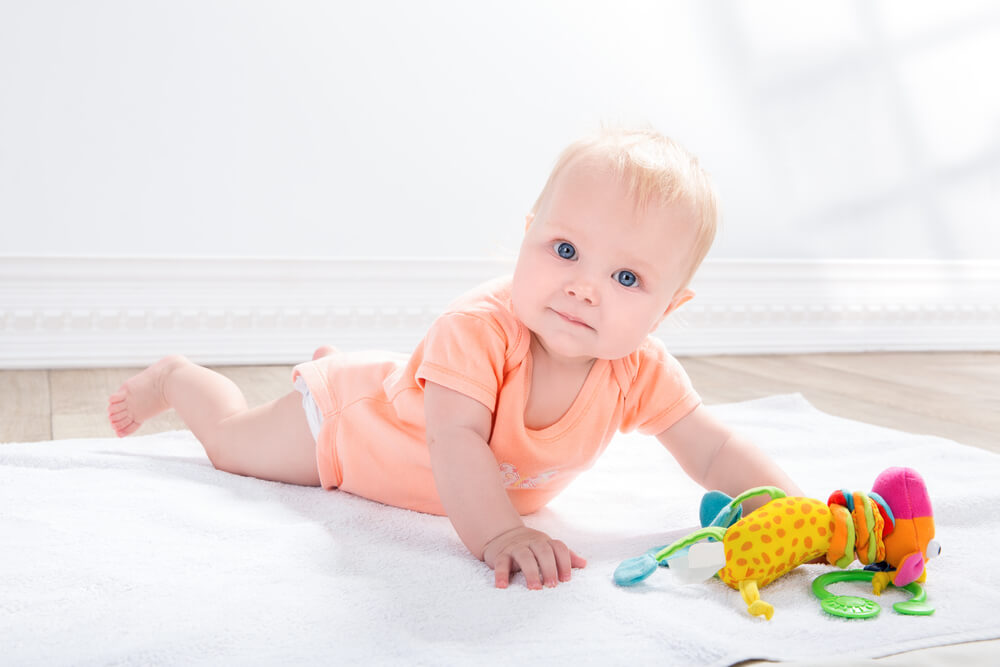
Prostock-studio/Shutterstock.com
A 6-month-old child is no longer afraid of new sounds. On the contrary, toys that make various sounds are of great interest to them. Buy a “singing” soft toy or children’s musical instruments for your kid — they will surely play with these objects for a long time and with pleasure.
Your child will enjoy new tactile sensations at this age: let them play with toys made from a variety of materials. Thanks to the development of vision, the baby will also like any bright-colored toys.
A six-month-old baby is interested in finger games, similarly to children of an earlier age, for example, the well-known “Rock-paper-scissors” or “Hot hands”. You can try to teach a child to assemble a pyramid, however, most children only take off rings by the age of six months. By playing regularly, children will master the principle of collecting and disassembling a pyramid in a few weeks.
Play a simplified version of hide and seek with your son or daughter — hide the toy in front of the baby and ask them to find it. Over time, the child will begin to look for the toy, even if they did not see where you hid it.
Taking care of a 6-month-old child
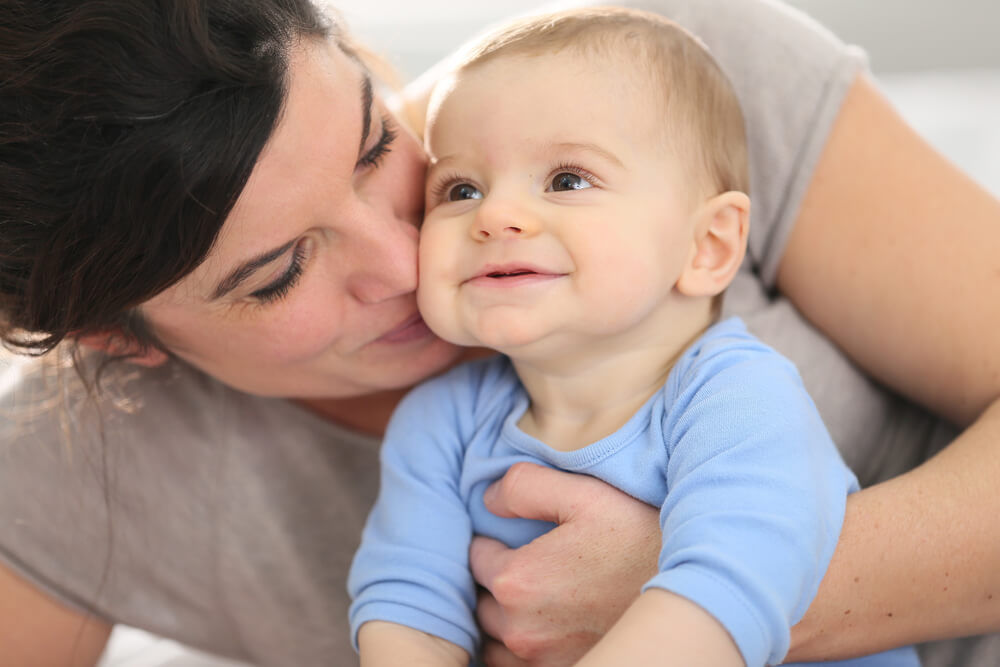
Prostock-studio/Shutterstock.com
Below are the main procedures of taking care of a 6-month-old baby:
- washing and bathing;
- keeping hair, nails, ears, and nose clean;
- brushing teeth — mandatory after a visit to a pediatric dentist and in accordance with their recommendations;
- immunity strengthening procedures: sun and air baths;
- bathing — once every two days or more often if necessary;
- light massage.
Read our article on How to strengthen the immunity of the child at home: the rules of health conditioning.
The doctor’s opinion

Prostock-studio/Shutterstock.com
Renowned pediatricians advise anxious parents to reduce the degree of their worry. Doctors assure that there is no single norm for all children and that parents should not force the baby to develop faster if they are lagging behind their peers in some way.
Doctors believe that there is no need to teach a six-month-old child to sit and crawl if they do not strive for these movements on their own. The baby will certainly sit down and crawl sooner or later.
Doctors also dispel the myth that active salivation is a clue to teething. According to the doctor’s observations, many babies over three months of age salivate profusely, and the salivation process has nothing to do with the appearance of the first tooth.
Frequent issues and solutions

Prostock-studio/Shutterstock.com
Moms and dads of six-month-old babies often worry about the same problems that are easy to fix with the right approach.
1. Poor sleep and waking up frequently
Do not worry if the baby wakes up only for feeding — such awakenings are quite natural at this age. However, if the child refuses to be fed with the breast or the bottle, if they throw tantrums, or are simply awake at night — try to establish their sleep routine. Start by not putting the baby to bed too early. You can also have them take a bath before bedtime.
2. Frequent injuries
The child becomes much more active than before, and it can be more difficult to control them. Protect the space where the child spends most of their time: remove any small objects that the child can choke on inadvertently.
3. Crying, tantrums, and first teeth

Prostock-studio/Shutterstock.com
If the child is feeling restless with the appearance of their first teeth — for example, their temperature rises, they experience problems with digestion, you should contact the pediatrician. The doctor will prescribe some medication to relieve the symptoms of teething or will suggest other ways to deal with the problem.
Parents are often worried if their baby does not comply with the developmental norms established by pediatricians fully. In most cases, there are no major reasons to worry. However, there are several serious reasons presented below that will raise the need to consult a specialist:
- the child does not try to change their body posture;
- cannot hold their gaze on the same object for a long time, the baby’s gaze seems to be “wandering”;
- reacts to other people indifferently, even the mother;
- the child performs prolonged monotonous movements — for example, swinging their hands without interruption for several minutes.
How to help the child to develop?
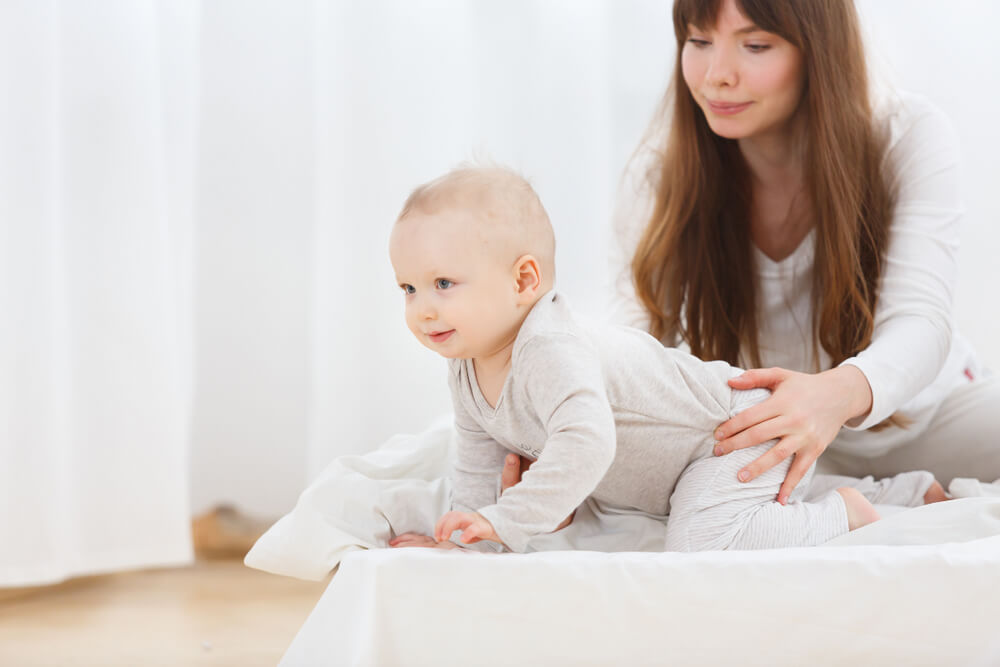
Prostock-studio/Shutterstock.com
Here are the ways by which parents can help a baby to develop correctly at the age of six months:
- Set up a safe place to play, such as a playpen. The baby will get used to some isolation and autonomy, allowing it to make the process of natural separation from the mother easier.
- Place bright and music toys on the floor inside the playpen or on the children’s rug. The kid will reach out for interesting objects whilst preparing their body for crawling.
- Choose age-appropriate toys: it shouldn’t be difficult for your child to play with them. If this is a musical toy, make sure that the music starts playing with just a light press.
- Buy the first book made of dense material for the baby.
- Communicate with your baby constantly so that they learn to speak faster. You can read the books, recite poems and short stories to your son or daughter, or just talk to them about any abstract topics.
Six months is a wonderful age. Sleepless nights are left behind (or almost behind), first teeth appear, and the baby starts displaying love and tenderness to loved ones. Play with your child, help them develop, and let most of the problems pass you by!
Проверьте электронный ящик



















